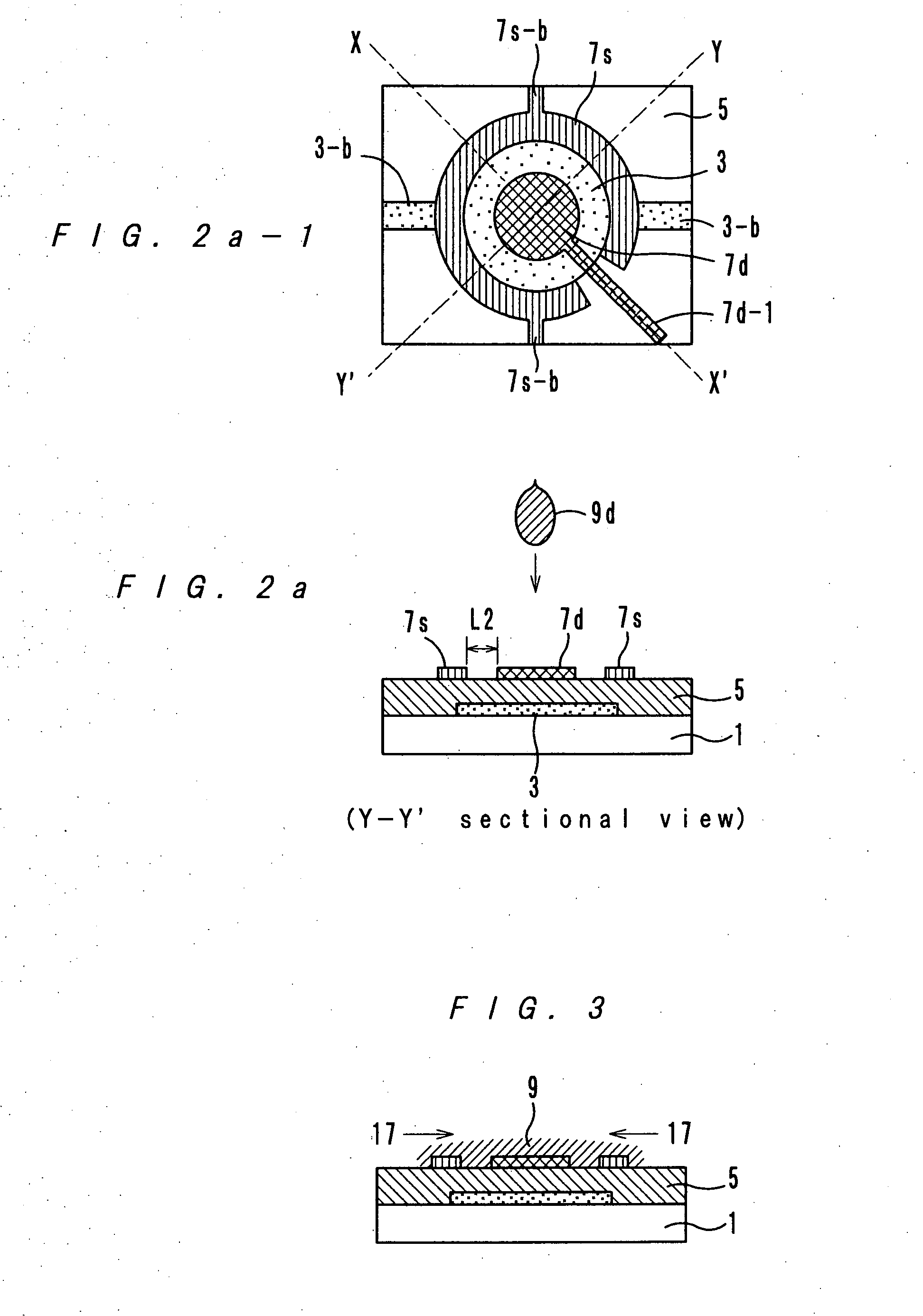Method for producing an organic thin film transistor and an organic thin film transistor produced by the method
- Summary
- Abstract
- Description
- Claims
- Application Information
AI Technical Summary
Benefits of technology
Problems solved by technology
Method used
Image
Examples
example 1
[0080] As a first example, an OFTF 100 of a bottom gate bottom contact type as shown by FIG. 1 was produced. The production processes are described referring to FIGS. 1a-1g.
[0081] On a glass substrate 1 shown by FIG. 1a, a kind of aluminum alloy, namely, aluminum-neodymium (AlNd), was formed into a film with a thickness of 150 nm by sputtering. Then, photolithography and etching were performed toward the AlNd film, and thereby, a circular gate electrode 3 was formed (see FIG. 1b).
[0082] Next, as a gate insulating film 5, SiO2 was formed into a film with a thickness of 300 nm by a plasma CVD process (see FIG. 1c).
[0083] Next, a resist pattern was formed by photolithography and etching so that a source electrode 7s which is a fragmental circle with a center hole and a drain electrode 7d which is in concentric with the source electrode 7s and which has a leading line 7d-1 could be formed by a lift-off method.
[0084] Next, a chromium film with a thickness of 5 nm was formed, and furt...
control example 1
[0089] As a control example 1, an OTFT 100R shown by FIGS. 12a-1 and 12a-12c which is of a bottom gate bottom contact type and of the same structure as the above-described example 1 was produced basically by using the same materials and the same processes as those of the example 1. The difference from the example 1 was that the source electrode 7s and the drain electrode 7d were not circular and were of an interdigital type.
[0090] Here, a channel length and a channel width are defined as follows. The channel length in the example 1 is a difference between a radius of the outer circumference of the drain electrode 7d and a radius of the inner circumference of the source electrode 7s (“L2” shown in FIG. 2a). The channel length in the control example 1 is a distance between a finger of the source electrode 7s and an adjacent finger of the drain electrode 7d (“L10” shown in FIG. 12a).
[0091] The channel width W2 in the example 1 is a length of the outer circumference of the drain elect...
example 2
[0097] As a second example, an OTFT 400 of a bottom gate bottom contact type was produced. The OTFT 400 was produced through the same processes as the OTFT 100 of the example 1. The differences from the OTFT 100 were that the OTFT 400 shown by FIG. 4a-1, had a circular source electrode 7s with a center hole and a circular drain electrode 7d and that the OTFT 400 had a contact hole 13 above the drain electrode 7d to connect the drain electrode 7d to a pixel electrode.
[0098]FIG. 4a shows a state wherein after forming a gate electrode 3 on a glass substrate 1, a gate insulating film 5 was formed, and further the source electrode 7s and the drain electrode 7d were formed on the gate insulating film 5. FIG. 4a is a sectional view taken along the line X-X′ in FIG. 4a-1.
[0099]FIG. 4b shows a state wherein after forming the source electrode 7s and the drain electrode 7d, an organic semiconductor layer 9 was formed.
[0100]FIG. 4c shows a state wherein after forming the organic semiconducto...
PUM
 Login to View More
Login to View More Abstract
Description
Claims
Application Information
 Login to View More
Login to View More - R&D
- Intellectual Property
- Life Sciences
- Materials
- Tech Scout
- Unparalleled Data Quality
- Higher Quality Content
- 60% Fewer Hallucinations
Browse by: Latest US Patents, China's latest patents, Technical Efficacy Thesaurus, Application Domain, Technology Topic, Popular Technical Reports.
© 2025 PatSnap. All rights reserved.Legal|Privacy policy|Modern Slavery Act Transparency Statement|Sitemap|About US| Contact US: help@patsnap.com



